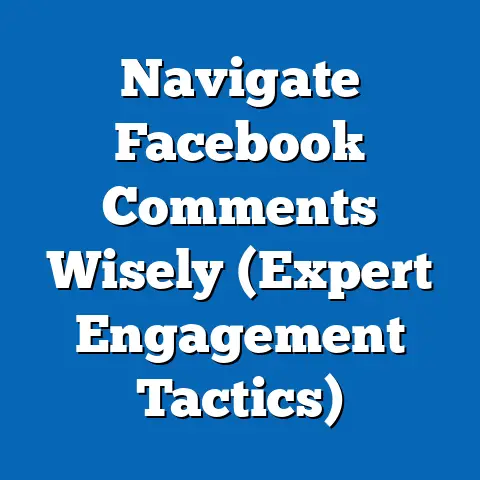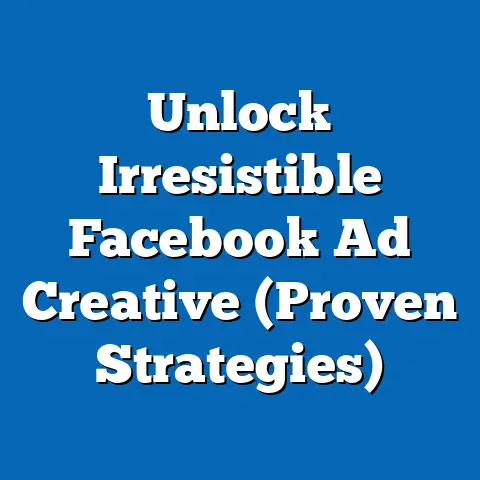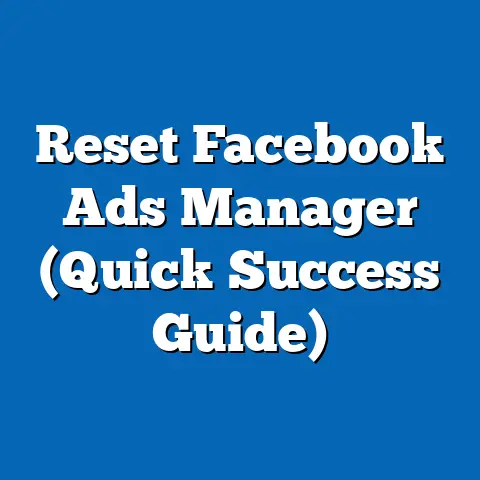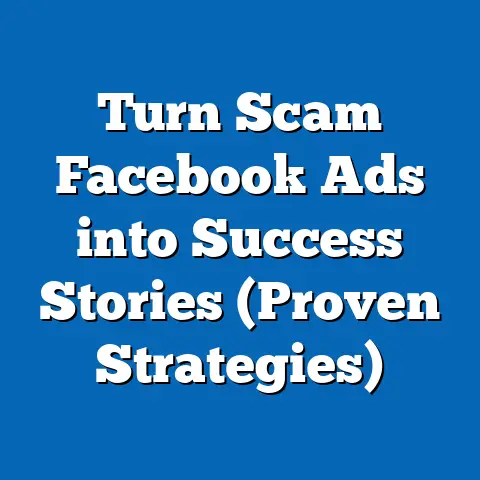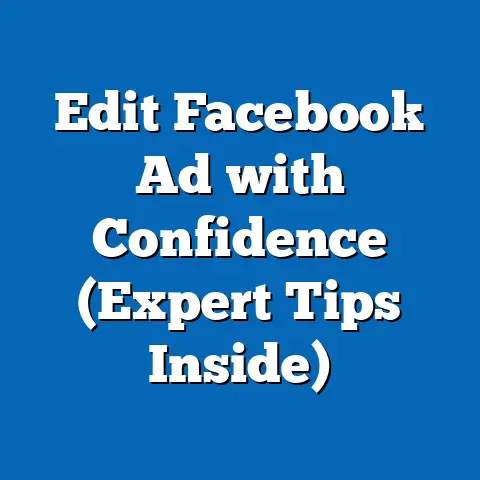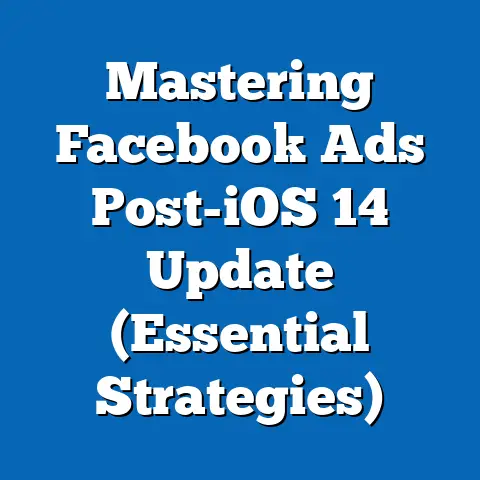Run Ads to Facebook Group Members (Unlock Hidden Potential)
In today’s digital world, it feels like everyone is screaming for attention. Businesses pour time, energy, and a whole lot of money into creating amazing content, hoping it will cut through the noise and connect with their ideal customers. But let’s be honest, how many ads do you actually remember seeing today? Probably not many.
Traditional advertising methods are facing an uphill battle. People are bombarded with so many ads that they’ve developed “ad fatigue.” They’ve learned to tune them out, scroll past them, or even install ad blockers. This means that even the most creative and well-funded campaigns can struggle to get the results they deserve.
I’ve seen this firsthand, working with clients who were frustrated with the declining effectiveness of their standard Facebook ad campaigns. They were targeting the right demographics, using compelling visuals, and crafting persuasive copy, but their engagement rates were plummeting. It felt like they were throwing money into a black hole.
Then, I started experimenting with a different approach: targeting ads specifically to Facebook group members. And that’s when things started to change.
While businesses invest significant time and resources into creating content, many fail to leverage the unique opportunities presented by Facebook groups. That’s why I want to talk about running ads targeted specifically to Facebook group members. It’s a strategy that taps into the power of community and offers a way to connect with a highly engaged, highly relevant audience. Think of it as finding a hidden oasis in the desert of digital advertising. This article explores the untapped potential that exists within these communities.
Section 1: Understanding Facebook Groups
Before diving into the specifics of advertising to Facebook group members, it’s essential to understand what Facebook groups are and why they’re so powerful.
Definition and Purpose
Facebook groups are online communities centered around shared interests, hobbies, professions, or goals. They provide a space for people to connect, share information, ask questions, and support each other. Unlike Facebook pages, which are primarily for broadcasting information, groups are designed for active participation and two-way communication.
I like to think of Facebook groups as the modern-day equivalent of local clubs or associations. They offer a sense of belonging and a platform for like-minded individuals to connect and engage.
The primary functions of Facebook groups include:
- Community Engagement: Fostering a sense of belonging and connection among members.
- Niche Discussions: Providing a space for in-depth conversations about specific topics.
- Support Networks: Offering peer support, advice, and encouragement.
- Information Sharing: Disseminating news, updates, and resources related to the group’s theme.
- Networking Opportunities: Connecting members with potential collaborators, clients, or employers.
The Rise of Facebook Groups
Facebook groups have experienced explosive growth in recent years, becoming an integral part of the platform’s ecosystem. In fact, Facebook reported that there are over 10 million Facebook groups, with over 1.8 billion people using them every month. This surge in popularity can be attributed to several factors:
- Increased Focus on Community: Facebook has actively promoted groups as a way to foster meaningful connections and combat the spread of misinformation.
- Growing Desire for Niche Communities: People are increasingly seeking out specialized communities where they can connect with others who share their passions and interests.
- Decline of Organic Reach on Pages: As organic reach on Facebook pages has dwindled, groups have emerged as a more effective way to reach and engage with audiences.
I’ve noticed this trend myself. Many of my clients have shifted their focus from building large Facebook pages to creating and nurturing smaller, more engaged groups. They’ve found that these groups provide a much more direct and impactful way to connect with their target audience.
Demographics and Targeting
One of the most significant advantages of Facebook groups is the ability to target ads to a highly specific and engaged audience. Group members often share common demographics, interests, and pain points, making them an ideal target for relevant and personalized advertising.
When analyzing the types of members that typically join groups, consider the following factors:
- Interests: What are the shared passions or hobbies that bring group members together?
- Demographics: What are the age, gender, location, and income levels of group members?
- Pain Points: What are the challenges or problems that group members are trying to solve?
- Goals: What are the aspirations or objectives that group members are working towards?
- Purchase Behavior: What types of products or services are group members likely to buy?
For example, a Facebook group dedicated to vegan cooking is likely to attract members who are interested in plant-based diets, health and wellness, and ethical consumption. This information can be invaluable for marketers who are selling vegan food products, cookbooks, or cooking classes.
By understanding the demographics and interests of Facebook group members, you can create highly targeted ad campaigns that resonate with their specific needs and desires. This leads to higher engagement rates, lower ad costs, and ultimately, better results.
Takeaway: Facebook groups are a powerful tool for community building and targeted advertising. By understanding the dynamics and demographics of these groups, you can unlock a wealth of opportunities for your business.
Section 2: The Benefits of Advertising to Facebook Group Members
Now that we’ve established the importance of Facebook groups, let’s explore the specific benefits of advertising to their members. This strategy offers several distinct advantages over traditional Facebook advertising methods.
Targeted Reach
One of the most compelling reasons to advertise to Facebook group members is the ability to reach a highly targeted audience. When you target your ads to people who are already members of a specific group, you can be confident that they have a genuine interest in the topic or niche that the group is focused on.
This targeted reach translates into higher engagement rates. Group members are more likely to pay attention to ads that are relevant to their interests, leading to more clicks, comments, and shares.
I’ve seen this play out time and time again. For example, I worked with a client who was selling online courses on digital marketing. When they targeted their ads to a general audience, their click-through rate was around 0.5%. But when they targeted their ads to members of Facebook groups dedicated to digital marketing, their click-through rate jumped to over 2%. That’s a fourfold increase!
Trust and Credibility
Advertising within a Facebook group can also help to build trust and credibility with your target audience. When group members see your ads within a community that they trust and value, they’re more likely to view your brand as authentic and reliable.
This is because people tend to trust recommendations from their peers and from communities that they’re a part of. By advertising within a Facebook group, you’re essentially leveraging the social proof and credibility of that community to build trust with your target audience.
I remember one instance where a client who was selling handmade jewelry started advertising in a Facebook group for craft enthusiasts. Initially, some members were skeptical, viewing the ads as intrusive. However, the client actively participated in the group, sharing tips, answering questions, and showcasing their craftsmanship. Over time, they built a reputation as a knowledgeable and trustworthy member of the community. As a result, their ads became much more effective, and they saw a significant increase in sales.
Community-Based Engagement
Advertising to Facebook group members also provides the opportunity to create more personalized and engaging ad experiences. Because you have a better understanding of the interests and needs of group members, you can tailor your ad copy, visuals, and offers to resonate with them on a deeper level.
This can lead to higher conversion rates and a stronger connection with your target audience. For example, you could create ads that address specific pain points that are commonly discussed within the group, or you could offer exclusive discounts to group members.
I’ve found that asking questions in your ads is a great way to encourage engagement. For example, if you’re selling a product that helps people solve a specific problem, you could ask, “Are you struggling with [problem]? Here’s how we can help.” This invites group members to share their experiences and connect with your brand on a more personal level.
Takeaway: Advertising to Facebook group members offers a unique opportunity to reach a highly targeted, engaged, and trusting audience. By leveraging the power of community, you can create more effective ad campaigns that drive meaningful results.
Section 3: Crafting Effective Ads for Facebook Groups
Advertising to Facebook group members isn’t just about targeting the right audience; it’s also about crafting the right message. To create effective ads that resonate with group members, you need to understand their specific interests, needs, and pain points.
Know Your Audience
Before you start creating your ads, take the time to research the Facebook groups that you’re targeting. Pay attention to the types of discussions that are happening, the questions that are being asked, and the challenges that are being shared.
Here are some strategies for understanding your audience:
- Join the Group: Immerse yourself in the community by becoming an active member.
- Read Past Posts: Review previous discussions to identify common themes and concerns.
- Observe Interactions: Pay attention to how members interact with each other and with the group’s administrators.
- Conduct Surveys: Create polls or surveys to gather direct feedback from group members.
- Analyze Demographics: Use Facebook Audience Insights to gain a deeper understanding of the group’s demographics and interests.
I always recommend starting by lurking in the group for a few days or weeks before you start posting or advertising. This will give you a feel for the group’s culture and the types of content that resonate with its members.
Ad Formats
Facebook offers a variety of ad formats that can be used to engage with Facebook group members. The best format for your campaign will depend on your goals, your budget, and the specific characteristics of the group you’re targeting.
Here are some popular ad formats for Facebook groups:
- Image Ads: Simple and effective for showcasing products or services with a compelling visual.
- Video Ads: Highly engaging and ideal for telling stories or demonstrating product features.
- Carousel Ads: Allow you to showcase multiple images or videos in a single ad, perfect for highlighting a range of products or services.
- Collection Ads: Designed for e-commerce businesses, these ads feature a product catalog with a visually appealing layout.
- Lead Ads: Enable you to collect leads directly from your ads, making it easy to capture contact information from interested group members.
- Story Ads: Immersive and engaging, these ads appear in the Stories section of Facebook and can be a great way to reach a younger audience.
I’ve found that video ads tend to perform particularly well in Facebook groups. People are more likely to stop and watch a video than they are to read a long block of text. Just make sure your video is high-quality, engaging, and relevant to the group’s interests.
Messaging and Tone
Here are some tips for crafting effective messaging:
- Speak Their Language: Use the same terminology and jargon that group members use.
- Address Their Pain Points: Show that you understand the challenges they’re facing and offer solutions.
- Highlight the Benefits: Focus on how your product or service can improve their lives.
- Be Authentic: Share your own experiences and insights to build trust and credibility.
- Ask Questions: Encourage engagement by asking questions that invite responses.
I always try to adopt a conversational tone in my ads. I want to sound like a fellow group member, not a corporate spokesperson. This helps to break down barriers and make people more receptive to my message.
Visual Elements
The visual elements of your ads are just as important as the messaging. Use high-quality images and videos that are visually appealing and relevant to the group’s aesthetic and culture.
Here are some tips for creating eye-catching visuals:
- Use Bright Colors: Capture attention with vibrant colors that stand out in the news feed.
- Showcase Real People: Use images of real people using your product or service.
- Create Compelling Graphics: Design eye-catching graphics that communicate your message clearly.
- Use Video Subtitles: Add subtitles to your videos to ensure that they’re accessible to everyone.
- Optimize for Mobile: Ensure that your visuals look good on mobile devices, as most Facebook users access the platform on their phones.
I’ve found that using user-generated content (UGC) can be a great way to create authentic and engaging visuals. Ask your customers to share photos or videos of themselves using your product or service, and then use that content in your ads. This can help to build trust and credibility with potential customers.
Takeaway: Crafting effective ads for Facebook groups requires a deep understanding of your audience, the right ad format, compelling messaging, and eye-catching visuals. By following these tips, you can create ads that resonate with group members and drive meaningful results.
Section 4: Best Practices for Running Ads in Facebook Groups
Creating great ads is only half the battle. To maximize the effectiveness of your campaigns, you need to follow best practices for running ads in Facebook groups.
Timing and Frequency
The timing and frequency of your ads can have a significant impact on their performance. You want to ensure that your ads are seen by as many group members as possible, but you also want to avoid overwhelming them with too many ads.
Here are some tips for optimizing your timing and frequency:
- Test Different Times: Experiment with running your ads at different times of day and days of the week to see what works best.
- Consider Group Activity: Pay attention to when the group is most active and schedule your ads accordingly.
- Avoid Over-Frequency: Don’t bombard group members with too many ads in a short period of time.
- Use Frequency Capping: Set a frequency cap in Facebook Ads Manager to limit the number of times each person sees your ads.
I’ve found that running ads in the evenings and on weekends tends to be most effective, as people are more likely to be browsing Facebook during those times. However, it’s important to test different times to see what works best for your specific target audience.
Testing and Optimization
Testing and optimization are essential for maximizing the effectiveness of your Facebook ad campaigns. You should constantly be experimenting with different ad variations to see what resonates best with group members.
Here are some things you can test:
- Headlines: Try different headlines to see which ones grab attention and generate clicks.
- Body Copy: Experiment with different messaging to see which resonates best with group members.
- Visuals: Test different images and videos to see which ones are most visually appealing.
- Calls to Action: Try different calls to action to see which ones drive the most conversions.
- Targeting Options: Experiment with different targeting options to see which ones reach the most relevant audience.
I always recommend running A/B tests to compare different ad variations. This allows you to see which version performs best and make data-driven decisions about your campaigns.
Engagement Strategies
Encouraging interaction with your ads can help to boost their performance and build a stronger connection with your target audience.
Here are some ways to encourage engagement:
- Ask Questions: Pose questions in your ads that invite responses from group members.
- Run Polls: Create polls to gather feedback and insights from group members.
- Offer Contests: Host contests or giveaways to generate excitement and engagement.
- Respond to Comments: Actively respond to comments on your ads to build relationships with group members.
- Create a Sense of Community: Foster a sense of community by encouraging group members to share their experiences and connect with each other.
I’ve found that running polls is a great way to gather valuable feedback from group members. For example, if you’re launching a new product, you could run a poll asking people what features they’re most interested in. This can help you to refine your product and tailor your marketing efforts to meet the needs of your target audience.
Monitoring and Analytics
Tracking your ad performance is crucial for understanding what’s working and what’s not. You should regularly monitor your key metrics and make adjustments to your campaigns as needed.
Here are some metrics to track:
- Reach: The number of people who saw your ads.
- Impressions: The number of times your ads were displayed.
- Click-Through Rate (CTR): The percentage of people who clicked on your ads.
- Cost Per Click (CPC): The average cost you paid for each click on your ads.
- Conversion Rate: The percentage of people who took a desired action after clicking on your ads (e.g., making a purchase, filling out a form).
- Return on Ad Spend (ROAS): The amount of revenue you generated for every dollar you spent on ads.
I use Facebook Ads Manager to track my ad performance. It provides a wealth of data and insights that can help you to optimize your campaigns for better results.
Takeaway: Running effective ads in Facebook groups requires careful planning, testing, and optimization. By following these best practices, you can maximize the reach, engagement, and ROI of your campaigns.
Section 5: Case Studies and Success Stories
To illustrate the power of advertising to Facebook group members, let’s take a look at some real-world examples and success stories. These case studies showcase how businesses in various industries have successfully leveraged this strategy to achieve their marketing goals.
Real-World Examples
Case Study 1: Local Restaurant
A local restaurant wanted to increase its lunch business. They targeted ads to members of Facebook groups focused on local foodies and community events. Their ads featured mouthwatering photos of their lunch specials and offered a 10% discount to group members. As a result, they saw a 20% increase in lunch revenue within the first month.
Key Takeaway: By targeting their ads to local foodies, the restaurant was able to reach a highly relevant audience who were already interested in trying new restaurants.
Case Study 2: Online Fitness Coach
An online fitness coach wanted to attract new clients. She targeted ads to members of Facebook groups focused on weight loss, healthy living, and fitness challenges. Her ads featured testimonials from satisfied clients and offered a free consultation to group members. As a result, she booked 15 new clients within the first two weeks.
Key Takeaway: By targeting her ads to people who were actively seeking to improve their fitness, the coach was able to attract highly motivated clients who were ready to commit to her program.
Case Study 3: E-Commerce Store
An e-commerce store selling handmade jewelry wanted to increase its online sales. They targeted ads to members of Facebook groups focused on crafts, fashion, and handmade goods. Their ads featured stunning photos of their jewelry and offered free shipping to group members. As a result, they saw a 30% increase in online sales within the first month.
Key Takeaway: By targeting their ads to people who were passionate about handmade goods, the store was able to reach a highly engaged audience who were likely to appreciate the unique craftsmanship of their jewelry.
Diverse Industries
The success stories above demonstrate that advertising to Facebook group members can be effective across a wide range of industries. Here are some other examples:
- Retail: A clothing store could target ads to members of Facebook groups focused on fashion and style.
- Education: A university could target ads to members of Facebook groups focused on career development and higher education.
- Non-Profits: A charity could target ads to members of Facebook groups focused on social causes and community involvement.
- Real Estate: A real estate agent could target ads to members of Facebook groups focused on local neighborhoods and housing market trends.
- Technology: A software company could target ads to members of Facebook groups focused on specific software tools and technologies.
The key is to identify the Facebook groups that are most relevant to your target audience and tailor your ads to resonate with their specific interests and needs.
Lessons Learned
After analyzing numerous case studies and success stories, I’ve identified some common themes and lessons that can be drawn from these experiences:
- Relevance is Key: The more relevant your ads are to the interests of group members, the more effective they will be.
- Community Matters: Building a sense of community around your brand can help to foster trust and loyalty.
- Engagement Drives Results: Encouraging interaction with your ads can lead to higher conversion rates and a stronger connection with your target audience.
- Testing and Optimization are Essential: Continuously testing and optimizing your ads can help you to improve their performance over time.
- Patience is Required: Building a successful advertising campaign in Facebook groups takes time and effort. Don’t get discouraged if you don’t see results immediately.
By learning from the experiences of others, you can increase your chances of success when advertising to Facebook group members.
Takeaway: Case studies and success stories demonstrate that advertising to Facebook group members can be a highly effective strategy for businesses in various industries. By following the lessons learned from these examples, you can increase your chances of achieving your marketing goals.
Conclusion
In conclusion, targeting Facebook group members with ads holds a treasure trove of untapped potential for businesses looking to enhance their reach and engagement. In a digital landscape where traditional advertising is often met with skepticism and ad fatigue, the community-focused approach of Facebook groups offers a refreshing and effective alternative. By tapping into the engaged audiences within these groups, businesses can not only enhance their reach but also foster deeper connections with their target market, ultimately driving more meaningful interactions and conversions.
I’ve seen firsthand how this strategy can transform a struggling campaign into a resounding success. It’s not just about reaching more people; it’s about reaching the right people with the right message.
Therefore, I encourage you to reevaluate your advertising strategies and consider the unique advantages presented by targeting Facebook group members. By understanding the dynamics of these communities, crafting relevant and engaging ads, and following best practices for testing and optimization, you can unlock a wealth of opportunities for your business.
The key is to think of Facebook groups not just as places to advertise, but as communities to connect with. By becoming a part of the conversation, offering value, and building relationships, you can create a lasting connection with your target audience and drive meaningful results for your business. So go ahead, dive in, and discover the hidden potential that awaits you within the vibrant world of Facebook groups.

